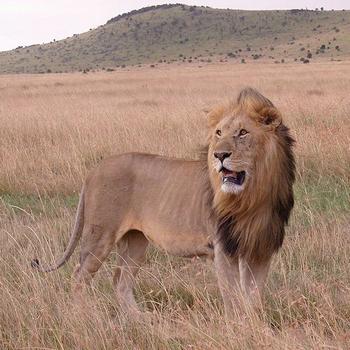 肯亞野生動物局(Kenya Wildlife Service)於8月17日警告說,如果繼續按照目前的下降速度,除非採取緊急和果斷的措施,否則肯亞的獅子在未來20年内將消失殆盡。
肯亞野生動物局(Kenya Wildlife Service)於8月17日警告說,如果繼續按照目前的下降速度,除非採取緊急和果斷的措施,否則肯亞的獅子在未來20年内將消失殆盡。
肯亞以其豐富的野生動物而聞名世界,目前在境内7個國家公園和保護區有2,000隻獅子。但過去七年裡獅子的數量卻以平均每年100隻的速度不斷下滑。
野生動物局發言人巫竇托(Paul Udoto)表示,獅子「由於諸多因素,包括人類與野生動物之間的衝突、棲地破壞、氣候暖化、疾病、人口快速增加等因素」而致死。
動物局的第一任主席,保育學者李基(Richard Leakey)博士,目前帶領非營利野生生物保護組織Wildlife Direct表示,許多獅子死於誤食含劇毒加保扶(carbofuran)殺蟲劑的動物屍體。李基接受BBC採訪時說,該殺蟲劑為肯亞農村民衆所熟知的一種簡易擺脫掠食者的方法。他正試圖遊說政府機關禁止該殺蟲劑的使用。
獅子的數量已從2002年約2,749隻下降到2004年的2,280隻,再到目前的2,000隻。
巫竇托表示,為了扭轉這一趨勢,動物局正起草一項全面性的國家獅子保育和管理策略, 並訂於9月開始實施。
本周在安博塞利(Amboseli)國家公園一個由12名肯亞野生動物局成員組成的科學家小組,著手幫兩隻獅子換上新的追踪裝置器。這兩個項圈是在2007年7月間安裝在安博塞利國家公園内的獅子身上其中5個裝置的一部份。目的為觀察獅子的行動和理解公園生態系内人獅之間的衝突。
 過去兩年中,野生動物局的科學家一直從5隻獅子身上的追踪裝置器收集到他們的行動模式,直到2個項圈過期並停止傳輸數據。
過去兩年中,野生動物局的科學家一直從5隻獅子身上的追踪裝置器收集到他們的行動模式,直到2個項圈過期並停止傳輸數據。
獅子是來自世界各地遊客造訪肯亞參觀的5種大型動物之一。觀光業佔肯亞國內生產總值的10%,排名生產總值第三大的產業,僅次於農業和製造業。 2007年,大約有2百萬遊客入境該國,比起2006年的1.6百萬人次有所增長。
肯亞觀光部長說,一個蓬勃發展的觀光產業有助於保護環境,因為保護良好的環境對於該產業而言具有資源基礎的價值。
按總部設在美國,支援肯亞獅子保育和研究中心(Centre for Lion Conservation and Research)的非營利機構獅子保護基金會(Lion Conservation fund)表示,最近的研究顯示,整個非洲的獅子數量可能在過去十年中已減少了近90%,僅剩下分佈在少數幾個國家不到20,000隻的獅子。
Kenya could lose all its lions in the next 20 years if the current rate of decline continues unless urgent and decisive measures are taken, the Kenya Wildlife Service warned today.
World famous for its wildlife, Kenya now has 2,000 lions in seven national parks and conservation areas, but the lion population has been declining by an average of 100 animals per year for the past seven years.
Kenya Wildife Service spokesman Paul Udoto says lions are dying "due to a combination of factors, including human wildlife conflict, destruction of habitats, climate change, disease and increase in human population."
The first KWS chairman, conservationist Dr. Richard Leakey, who now chairs the nonprofit Wildlife Direct, says lions are dying from ingesting animal carcasses laced with toxic carbofuran pesticide. Carbofuran has become known in rural communities in Kenya as an easy way to get rid of predators, Leakey told the BBC. He is lobbying government agencies to ban the pesticide.
The population of lions has dropped from an estimated 2,749 in the year 2002 through 2,280 in 2004 to the current 2,000 animals.
To reverse this trend, Kenya Wildlife Service is drafting a comprehensive national lion conservation and management strategy to be launched in September, Udoto says.
A 12-member team of KWS scientists is in Amboseli National Park this week to replace movement tracking devices on two lions. The two collars were among five devices fitted on Amboseli lions in July 2007 in order to monitor their movements and understand human-lion conflict in the Amboseli ecosystem.
For the last two years, KWS scientists collected data on the five lions' movement patterns until the two collars expired and have stopped transmitting data.
The lion is one of the Big Five animals that visitors come to Kenya from all over the world to see. Tourism accounts for 10 percent of Kenya's Gross Domestic Product, making it the third largest contributor to the country's GDP after agriculture and manufacturing. In 2007, about two million visitors entered the country, up from 1.6 million arrivals in 2006.
The Kenya Ministry of Tourism says a thriving visitor industry provides encouragement for environmental conservation because of its value as a resource base for the industry.
Recent studies suggest that lion populations across Africa may have decreased nearly 90 percent in just one decade, with fewer than 20,000 remaining in just a handful of countries, according to the nonprofit Lion Conservation fund, based in the United States, which supports the Centre for Lion Conservation and Research in Kenya.




